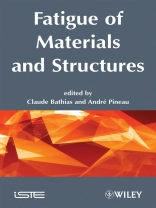The design of mechanical structures with improved and predictable durability cannot be achieved without a thorough understanding of the mechanisms of fatigue damage and more specifically the relationships between the microstructure of materials and their fatigue properties. Written by leading experts in the field, this book (which is complementary to Fatigue of Materials and Structures: Application to Damage and Design, also edited by Claude Bathias and André Pineau), provides an authoritative, comprehensive and unified treatment of the mechanics and micromechanisms of fatigue in metals, polymers and composites. Each chapter is devoted to one of the major classes of materials or to different types of fatigue damage, thereby providing overall coverage of the field.
The book deals with crack initiation, crack growth, low-cycle fatigue, gigacycle fatigue, shorts cracks, fatigue micromechanisms and the local approach to fatigue damage, corrosion fatigue, environmental effects and variable amplitude loadings, and will be an important and much used reference for students, practicing engineers and researchers studying fracture and fatigue in numerous areas of mechanical, structural, civil, design, nuclear, and aerospace engineering as well as materials science.
The book deals with crack initiation, crack growth, low-cycle fatigue, gigacycle fatigue, shorts cracks, fatigue micromechanisms and the local approach to fatigue damage, corrosion fatigue, environmental effects and variable amplitude loadings, and will be an important and much used reference for students, practicing engineers and researchers studying fracture and fatigue in numerous areas of mechanical, structural, civil, design, nuclear, and aerospace engineering as well as materials science.
Table des matières
PrefaceINTRODUCTION
A PIVOTAL ROLE OF SECONDARY OXIDE SCALE DURING HOT ROLLING AND FOR SUBSEQUENT PRODUCT QUALITY
Friction
Heat Transfer
Thermal Evolution in Hot Rolling
Secondary Scale-Related Defects
SCALE GROWTH AND FORMATION OF SUBSURFACE LAYERS
High-Temperature Oxidation of Steel
Short-Time Oxidation of Steel
Scale Growth at Continuous Cooling
Plastic Deformation of Oxide Scales
Formation and Structure of the Subsurface Layer in Aluminum Rolling
METHODOLOGY APPLIED FOR NUMERICAL CHARACTERIZATION OF OXDIE SCALE IN THERMOMECHANICAL PROCESSING
Combination of Experiments and Computer Modeling: A Key for Scale Charaterization
Prediction of Mild Steel Oxide Failure at Entry Into the Roll Gap as an Example of the Numerical Characterization of the Secondary Scale Behavior
MAKING MEASUREMENTS OF OXIDE SCALE BEHAVIOR UNDER HOT WORKING CONDITIONS
Laboratory Rolling Experiments
Multipass Laboratory Rolling Testing
Hot Tensile Testing
Hot Plane Strain Compression Testing
Hot Four-Point Bend Testing
Hot Tension Compression Testing
Bend Testing at the Room Temperature
NUMERICAL INTERPRETATION OF TEST RESULTS: A WAY TOWARD DETERMINING THE MOST CRITICAL PARAMETERS OF OXIDE SCALE BEHAVIOR
Numerical Interpretation of Modified Hot Tensile Testing
Numerical Interpretation of Plain Strain Compression Testing
Numerical Interpretation of Hot Four-Point Bend Testing
Numerical Interpretation of Hot Tension-Compression Testing
Numerical Interpretation of Bend Testing at Room Temperature
PHYSICALLY BASED FINITE ELEMENT MODEL OF THE OXIDE SCALE: ASSUMPTIONS, NUMERICAL TECHNIQUES, EXAMPLES OF PREDICTION
Multilevel Analysis
Fracture, Ductile Behavior, and Sliding
Delamination, Multilayer Scale, Scale on Roll, and Multipass Rolling
Combined Discrete/Finite Element Approach
UNDERSTANDING AND PREDICTING MICROEVENTS RELATED TO SCALE BEHAVIOR AND FORMATION OF SUBSURFACE LAYERS
Surface Scale Evolution in the Hot Rolling of Steel
Crack Development in Steel Oxide Scale Under Hot Compression
Oxide Scale Behavior and Composition Effects
Surface Finish in the Hot Rolling of Low-Carbon Steel
Analysis of Mechanical Descaling: Low-Carbon and Stainless Steel
Evaluation of Interfacial Heat Transfer During Hot Steel Rolling Assuming Scale Failure Effects
Scale Surface Roughness in Hot Rolling
Formation of Stock Surface and Subsurface Layers in Breakdown Rolling of Aluminum Alloys
OXIDE SCALE AND THROUGH-PROCESS CHARACTERIZATION OF FRICTIONAL CONDITIONS FOR THE HOT ROLLING OF STEEL: INDUSTRIAL INPUT
Background
Brief Summary of the Main Friction Laws Used in Industry
Industrial Conditions Including Descaling
Recent Developments in Friction Models
Application of Hot Lubrication
Laboratory and Industrial Measurements and Validation
Industrial Validation and Measurements
Conclusions and Way Forward
A propos de l’auteur
Claude Bathias is Emeritus Professor at the University Paris 10-La Defense. He started his career as a research engineer in the aerospace and military industry where he remained for 20 years before becoming director of the CNRS laboratory ERA 914 at the University of Compiegne. He has launched two international conferences about fatigue: International Conference on the Fatigue of Composite Materials (ICFC) and Very High Cycle Fatigue (VHCF).André Pineau is Professor at Mines Paris Tech and a member of the French Academy of Engineering. He has published about 300 papers in international journals and edited or co-edited 10 books. His main research fields are phase transformations, fatigue and fracture of metallic materials.
Buy this ebook and get 1 more FREE!
Langue Anglais ● Format PDF ● Pages 512 ● ISBN 9780470394014 ● Taille du fichier 17.2 MB ● Éditeur Claude Bathias & André Pineau ● Maison d’édition John Wiley & Sons ● Publié 2013 ● Édition 1 ● Téléchargeable 24 mois ● Devise EUR ● ID 2652229 ● Protection contre la copie Adobe DRM
Nécessite un lecteur de livre électronique compatible DRM












